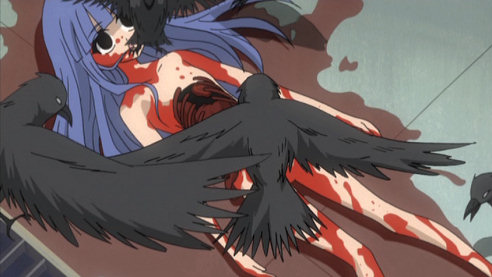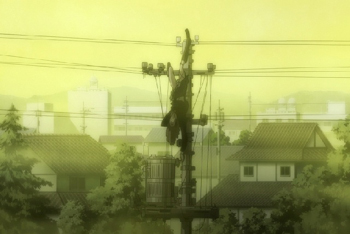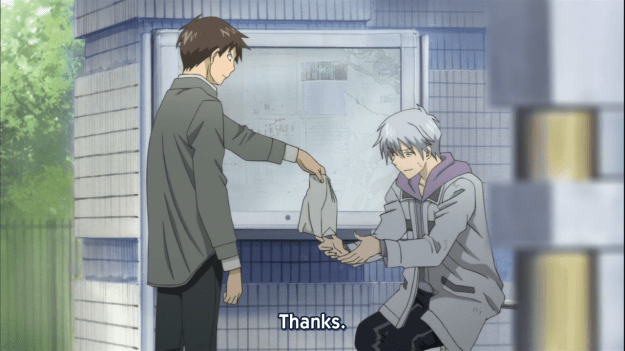Watching the two nobodies get slaughtered at the start of the latest episode of Kamisama Dolls got me thinking. The West has a certain conception of Japan, a conception that often obfuscate a very latent fear in anime: a fear of Japanese villages and the horrors they contain.
I generally have a comparative approach to anime and this post will be no different. Before we dive into the nitty gritty, I want to bring to mind David Lynch and his body of work. Specifically, I want to call attention to Lynch’s penchant for subverting wholesome America into something dark and absurdist. In Twin Peaks, arguably the only work of Lynch to garner mass appeal, FBI Agent Cooper digs beneath the wholesome facade of a small American town to uncover a web of lies, crime and, ultimately, supernatural horror. In an even earlier work, Blue Velvet, the Lynchian horror shifts to a suburban setting of immaculate lawns and white picket fences. Like Twin Peaks, Blue Velvet’s Lumberton disguises its dark underbelly under a veneer of upper-middle class bliss. Even the name of the town lulls one into a sense of false security.

The familiar white picket fence.
Both Twin Peaks and Blue Velvet serve to illustrate that there is something rotten at the core of American values — that a world “immersed in banality and drowning in absurdity [will eventually]… self-destruct” (source). At this point, I want to suggest that something very similar is at work in Japanese anime. Wholesome American towns and suburban life will instead be replaced by the quaint, idyllic Japanese towns and villages, but in both cultures, horror lurks underneath. For a lot of these towns and villages, there is always a dark secret hiding behind the placid smiles and quaint rituals of the village people.
Of course, not all anime featuring Japanese villages takes on a horror approach. Many series feature a city boy or gal packing his or her bags and taking a long train ride out to a quiet town. Their arrival almost always coincides with the onset of some festival of sorts (e.g. the Bonbori festival in Hanasaku Iroha). For a lot of these anime series, the peaceful setting of a small town or village is where the main character can unwind from the stress one typically finds in city life. Their health and attitude often improve and their lives slow down just enough that they can freely enjoy their pubescent years.
There exists, however, a body of work in Japan very similar to Lynchian horror. I will try to list a few examples:

Furude Rika of Higurashi no Naku Koro ni
(1) In the Higurashi no Naku Koro ni series, Keiichi, a young boy, moves to the Hinamizawa village. At first, his new home seems peaceful and banal as the villagers go about their daily lives. Keiichi learns, however, that someone will always mysteriously die on the day of an annual festival. Our protagonist finds himself embroiled in a bizarre mystery involving him and his friends. We eventually learn through the course of the anime’s two seasons that the cause for the mental breakdown of the series’ characters is due to some pathological disease.
(2) Likewise, Shiki has Natsuno move from a city to a quaint village called Sotoba. Shortly after he arrives, people begin to mysteriously die from a blood-related disease. We soon find out that a group of vampires have descended upon the village. In this case, then, the horror came from outside the village, but it’s worth noting that the proliferation of the shiki within the narrative context of the anime is only possible due to isolated nature of a small town.
(Day of GAR GAR Stegosaurus, your resident Shiki fanatic, tells me that although the shiki came from elsewhere, “there may’ve been creatures like them lurking about Sotoba once before.”)

Inaba finds itself enveloped in a murder mystery in Persona 4.
(3) In Shin Megami Tensei: Persona 4, an unnamed young man (soon to be named in the anime adaptation) moves to Inaba where he, too, finds himself in the midst of a murder mystery. Persona 4’s story takes on a much more light-hearted tone than the two previous works, but like Higurashi and Shiki, there are apparent similarities.
(4) Okami Kakushi follows the same familiar trend: a young boy and his family moves to a small village. He quickly and easily makes friends with his oddly friendly classmates. Through the course of the anime, he finds out that the village contains werewolves. The village’s many rituals are necessary to keep the peace between the normal citizens and their more supernatural neighbors.

From Siren: Blood Curse.
(5) Siren, a survival horror video game series, follows the lives of several survivors in a small village as they cope with a sudden outbreak of shibito, the Japanese equivalent to the West’s shambling zombies. The characters of the story uncover the village’s occult past and its link to a mysterious being known only as the Datatsushi.
(6) My final example will be what inspired this post: Kamisama Dolls. Whereas most of the stories I’ve listed above takes place within a village, Kamisama Dolls flips the premise on its head. Instead of being a displaced city boy, Kuga is from a village. Perhaps due to a traumatic event, Kuga has decided to leave his home to study instead in the city. Right from the start, we are told of some of the village’s secrets (there are undoubtedly more to uncover). Unfortunately for Kuga, he cannot escape the village; the village and his dark past literally follow him to the city.

A typical Japanese village.
Like Lynchian horror, these stories all feature the idea that Japanese villages contain secrets unbeknownst to the rest of society. The townspeople are not always complicit in the dark affairs lurking beneath the small town charm, but their genial nature helps to mask the true horror underneath. What makes this subversion of wholesome Japanese villages ever the more interesting is the juxtaposition of the latent fear found in these stories against the common world perception of Japanese culture.
In the West, we often see Japanese culture as nature- and tradition-bound. Anime that do manage to transcend the medium’s niche status overseas often paint the picture that the Japanese worship nature more so than other first world countries, that the Japanese are wary of technological advances, that the Japanese are spiritual folks steeped in rituals and traditions, etc. The prevalence of festivals or religious rituals in the horror stories listed above, then, is not simply a coincidence. These horror stories take Japanese ideals, of a simplistic village and its quaint rituals, and turns them into something bizarre, evil, supernatural or all of the above.
At this point, however, I want to develop Lynchian horror a little further. Although Lynch does imply that small American towns and suburban life are really not as wholesome as we think, his approach is not cynical as one might expect. In Twin Peaks, FBI Agent Cooper sees the horror before him, but it doesn’t turn him away. In fact, he finds joy in every little thing the town has to offer. From the trees to the coffee to the pies they serve at the local diner, Cooper relishes the small town atmosphere of Twin Peaks despite the darkness he was sent to combat. What Lynch seems to then suggest is that the horror and darkness one finds in small towns and suburban life is simply a part of the American experience. He acknowledges the flaws of the world he lives in, but he doesn’t reject them either. He simply accepts that horror is a part of life.
We see a similar mindset in most of the Japanese horror stories listed above. The narrative structure in a lot of these tales follow a familiar format: the outsider arrives and falls in love with his or her new home, the honeymoon period ends, the outsider fights for his or her new home and then, finally, peace is restored. There are subtle differences here and there, but in general, if life in Japanese villages is really that bad, why not just leave? The protagonists generally don’t, however, because in those brief, early moments of bliss in the narrative, they’ve gleaned something positive from their new home similar to whatever value Cooper sees in a simple cup of coffee in Twin Peaks. The protagonists will then fight and learn to adapt to their new surroundings, even if this means putting their lives at risk. There’s something rotten at the core of Japanese villages, but, perhaps like Lynch, we must accept the bad with the good.
(Shiki, of course, treats the illness as incurable and the only feasible option is complete destruction of both the village and the horror within.)
Kamisama Dolls Ep. 3: Thoughts & Impressions
• Welcome back to Utao’s Comedy Variety Half-Hour! This week, we eat delicious caeki~
This is new and exciting.
• Utao and Hibino spend time bonding in this episode. As a result, we learn this week that the dolls can go underwater. This better be relevant in future episodes.
• I am dumbfounded by Kuga’s reaction to Aki. This guy is deranged and a murderer. He’s obviously a threat to anyone around him. So what does Kuga do?
He buys his old friend food and asks him nicely to go back home to the village. It’s only the third episode and I’ve already soured on the male protagonist of the series.
• This episode introduces two more characters to the mix and we know for sure that one of them can control a doll much like Utao and Aki. I take a rather conservative approach to introducing characters willy-nilly to any story. At some point, you’ll just detract valuable development time from the main characters.






Seeing as I’ve never seen Twin Peaks, something that I do want to rectify, the comparison that I drew the connection to while reading was Deadly Premonition, which was pretty much Twin Peaks in an awful, yet oddly compelling video game.
As this shows, the paranoia fuel intrinsic to American works of that sort (Shadow over Innsmouth could count, though things were somewhat fishy to begin with, pardon the pun) does cross cultural boundaries. There’s something inherently interesting in seeing a facade of wholesomeness chipped away by an outsider, whether intentional or no.
It goes without saying that the method that Kamisama Dolls is using, by taking evidence that the protagonists come across outside the village and presenting it to the audience to draw their own conclusions, is somewhat unconventional when compared to the cases you mentioned above. And that’s the only place where I think the potential for this show lies. While I’d hesitate to call anything but the animation mediocre, it isn’t fitting together or pacing itself as well as it should.
Oddly enough, the guy behind Deadly Premonition claims that Twin Peaks didn’t serve as an inspiration for his game. Yeah, likely story…
As for Kamisama Dolls, the last two episodes have been rather disappointing. The shifts in tone from murderous action to wacky Utao time are just too jarring to really make the anime enjoyable.
That’s REALLY hard to believe, considering everyone else has drawn the conclusion that it’s inspired by Twin Peaks.
In fact, the game used to resemble Twin Peaks even more, but apparently, this came at a surprise to the developers so they had to redo a lot of the game, including the voice acting.
Huh. That’s either the greatest series of coincidences ever, or a lie to disguise how much Twin Peaks did influence it. Of course the finished product was great in its own odd way, so it doesn’t make any difference either way.
I’m not watching Kamisama Dolls, but the subject of the inaka is very near and dear, since I’ve lived in one for the past two years. I often hear from locals that “city and country people don’t mix.” And in the case of Shiki in particular, there’s nothing quite so strange as a village in the mountains named literally soto-ba, the “outside place.”
That’s too bad seeing as how most anime seem to have these quaint little villages on a pedestal. Sure, weird stuff happens, but that just seems to be anime’s way of saying that weirdness is part and parcel for anyone moving from the city to the countryside.
Do you see there being any resentment of the countryside from the city folks? I’ve been reading about how hideously malapportioned Japanese electoral districts are, and how propped-up by urban taxpayers the agricultural sector is, and wondered if it might tie into the overall attitude towards the villages. Then again, we don’t hate Iowans for their fat corn subsidies and crazy voter/senator ratio, so maybe that stuff doesn’t really filter into popular consciousness.
Whoa, a reply by The Fin! :) Long time no see!
I’ve only talked a few times about Tottori with people from Tokyo. The reaction was generally “that’s really far away” and “they have such funny accents.” But I suppose you’d have to get close enough personally to start talking politics, and much like America that’s incredibly hard to do here.
Ah, that makes sense. And yeah, been too long :3. You know how it goes, though. Busy busy.
Hey did you see my blurb about Warau Kanako-sama?! It’s practically the only thing I’ve written here in a year, and it seems like I’m the only English-speaker who read the manga, but I had some wild hope that it was the sort of semi-obscure series you might catch wind of.
Stop fraternizing with the enemy and get back to work!
I did see your post. :) And I actually read it thanks to that.
Hah! And E Minor made fun of me. “No one reads manga, fin”.
For this blatant act of disrespect, I’ve stripped you of your editor privileges!
A somewhat related comment: It seems that every anime character and his mother, father, younger sister, and childhood friend all have a “hometown” out in the sticks. If city life doesn’t go well, come back to the family farm (and get brutally raped and killed by vampires)! I was reading Yotsuba&! the other day and realized that even Koiwai came from the boonies. Maybe that little green-haired girl is actually a demon in disguise…
But yeah, it seems that “disillusionment of city life” is a really hot theme in anime (Japanese media in general?), with or without that disillusionment bit.
I guess this raises the question: how many anime out there actually and explicitly like the city? We always see anime characters get off the train or bus, take a deep breath of the countryside air and go “DERP, THIS IS JUST WHAT I NEEDED.” Are there any equivalent scenes for the city?
Nope, unless they want to make a career of themselves. like “Today I begin my first steps to Success. The country is like ” Ah, a quiet vacation from that loud city. Nothing can possibly go wrong…
See for cities, it’s a rat race man. Ya gotta get some connections fast or y’all get left behind. Cities aren’t relaxing at all, unless you’re a tourist, a that’s basically exploration, which most anime characters don’t do when in the country, except for kids.
I’m afraid country life would be the hell out of me.
I can actually think of one: Durarara.
In a sense it takes the same idea of small villages hiding horrors and applies it to the city.
Mikado is a little trepidacious about the idea of living in the city but he’s also optimistic so it’s not exactly a “This is just what I need” moment but more of a “I’m cautiously optimistic about this” moment. I think you could also say 90% of the DRR characters explicitly like the city. Ikebukuro is practically a character in itself and the creator of DRR revels in making it as colorful as possible.
Ah, the anime I dropped after like five episodes.
aw, dont be like that, it got quite interesting after episode 8…
by the way, good blog,